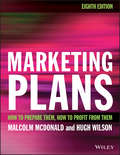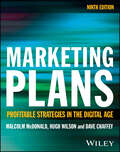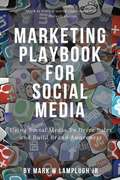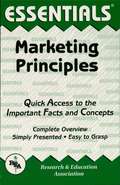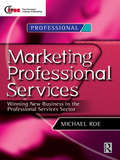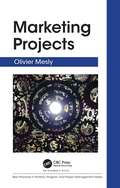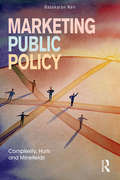- Table View
- List View
Marketing Plans: How to prepare them, how to profit from them
by Malcolm Mcdonald Hugh WilsonA fully revised and updated 8th edition of the highly renowned international bestseller The 8th edition of this highly acclaimed bestseller is thoroughly revised with every chapter having been updated with special attention to the latest developments in marketing. Marketing Plans is designed as a tool and a user-friendly learning resource. Every point illustrated by powerful practical examples and made actionable through simple, step-by-step templates and exercises. The book is established as essential reading for all serious professional marketers and students of marketing, from undergraduate and postgraduate to professional courses for bodies such as CIM. Above all it provides a practical, hands-on guide to implementing every single concept included in the text. New chapters and content include: A 'Does it Work' feature throughout demonstrating examples of real successes using the processes in the book More substantial coverage of consumer behaviour to balance the book's focus with B2B planning Digital techniques and practices brought fully up to date Also includes a comprehensive online Tutors' Guide and Market2Win Simulator for those who teach marketing strategy
Marketing Plans: Profitable Strategies in the Digital Age
by Hugh Wilson Dave Chaffey Malcolm McDonaldThe latest edition of the leading and internationally bestselling text on marketing planning In the newly revised ninth edition of Marketing Plans, a team of renowned marketing strategists and professors delivers a fully updated version of the gold standard in marketing planning textbooks. The book contains a proven, start-to-finish approach to planning your firm’s marketing and is complemented by brand-new content on digital marketing and sustainable marketing. The authors have also included best-practice guidance on omnichannel management, integrated marketing communications, key account management, and customer experience management. The book provides: A best-practice, step-by-step process for coordinating marketing strategy and planning Methods to create powerful, differentiated value propositions Tools to prioritise marketing efforts on segments and strategies that will deliver the greatest returns in growth and profits Lessons from the leaders on how to embed world-class marketing within the organisation. Perfect for students and executives alike in marketing, sales, strategy, and general management, Marketing Plans, 9th edition remains the world’s leading resource on the critical topic of marketing strategy and planning.
Marketing Playbook for Social Media: Using Social Media to Drive Sales and Brand Awareness
by Mark W LamplughThe information in this book will help you to create and grow a strong social media presence for your business that will allow you to obtain the all the potential that social media has to offer. Social Media is being highly adopted by the wider population therefore it is imperative to deliver the right message to the right platform.
Marketing Principles Essentials
by James FinchREA's Essentials provide quick and easy access to critical information in a variety of different fields, ranging from the most basic to the most advanced. As its name implies, these concise, comprehensive study guides summarize the essentials of the field covered. Essentials are helpful when preparing for exams, doing homework and will remain a lasting reference source for students, teachers, and professionals. Marketing Principles covers the marketing environment, market research, target markets, product planning and management, distribution systems, wholesaling and retailing, promotional strategy, pricing policies and strategies, marketing evaluation and control, marketing applications in special fields.
Marketing Professional Services
by Michael RoeMarketing Professional Services is a uniquely focused, incisive and practical introduction to new business planning, marketing and selling skills for those in the professional services sector. It is for professionals who have to sell to professionals. Professionals of all types, from accountants and consultants to surveyors and solicitors who have trained in a specific technical skill will understand the power of good clear marketing practice reading this book. If you have to sell yourself and your service to clients this book shows you:* The importance of winning new business in an increasingly competitive, deregulated market* How to plan for winning new business including a full script for cold calls * The techniques, skills and resources required in order to achieve your goals focusing on the three P's of Preparation, Prospection and PersistenceIndividual chapters provide you with a basic grounding in separate sales and marketing issues - from prospecting and cold canvassing to direct marketing and public relations. The book includes sample interactive conversations and provides a constant source of reference for the professional sales person. It is based on long experience of training in this sector and is a short, practical and appropriate introduction to the key concepts.
Marketing Projects (Best Practices in Portfolio, Program, and Project Management)
by Olivier MeslyMarketing is about placing a new product or service into the market. Projects are about delivering new products and services. The merger of these two fields holds great promise for delivering value to organizations and their clients. Project managers can serve many markets ranging from investors who fund projects to that of clients who use new products and services. Marketing Projects is a guide for helping project managers have projects funded or deliver value to end users. It is also a guide for marketing managers new to the world of project management. The book begins by presenting the basics of both marketing and project management and highlights the aspects that are unique and relevant to both areas. It then explores marketing project feasibility and presents tools for assessing feasibility, which include the 6Ps of project management strategy: The project 4Ps: plan, processes, people, and power PRO: pessimistic, realistic, and optimistic scenarios POVs: points of vulnerability POE: point of equilibrium POW: product, organization, and work breakdown structures PWP: work psychodynamics This book illustrates how to use these tools to market new projects to potential sponsors and investors. It then explores marketing projects to end users. Crucial to the success of projects are the relationships between project managers and clients and the way marketing experts implement their strategies. This book explains how project managers can develop meaningful relationships with clients to foster trust and have positive interactions. Project managers excel at managing the processes for delivering new products and services. Marketers are keenly aware of latent, or unconscious needs, as well as those developing and emerging, and can provide project promoters and managers with exciting ideas. This book will help improve the mutual understanding between marketing and project managers, an effort ultimately benefiting end users, whether they be investors or customers. A better work atmosphere and a closer fit between marketing and project management objectives can only serve the interests of investors and end users, for whom marketers and project managers conceive and realize projects, one way or the other.
Marketing Promotions
by Marta WosinskaIntroduces the major communication vehicles and the process by which they can be brought together in an integrated marketing communications plan.
Marketing Public Policy: Complexity, Hurts and Minefields
by Basskaran NairPolicy analysts and policy planners should start from the premise that obstacles, uncertainties and surprises are important features of policy-making. All public policies should be treated as complex problems, from the outset. Complexity theorists start from the premise that complex policies are ill-defined and ambiguous. There is often little consensus about what the problem is, let alone how to resolve it. Into the complexity of the wicked problem fray, Marketing Public Policy introduces the role of communication scholars and practitioners whose models and practices focus on people, processes, opinions and behaviour as causes of organisational complexity. Communication practice’s role is to provide ideas on how to navigate, diagnose and interpret issues with a view to persuading the public to change its behaviour or opinions. From the case studies presented in this book, we see that despite rationally excellent macro- and micro-planning of policies to win the hearts and minds of citizens, public policies still deteriorate into hurts and minefields. The case studies are drawn from China, Indonesia, India, the USA, the UK and Europe to show that policy-making is always a complex issue in any country, whatever the political structure, whether democracy or communism.
Marketing Reading: Brand Positioning
by Jill Avery Sunil GuptaThis Reading addresses the principles of brand positioning and demonstrates how companies can strategically craft powerful, resonant, and unique brand positions to help products stand out amidst the cacophony of the marketplace. Strategic brand positioning provides consumers with the answer to the all-important question, "Why should I buy?" The Reading discusses how to craft a brand's value proposition for competitive advantage, through analysis and synthesis of consumer, company, and competitive factors. It highlights the types of brand positions that companies can stake out in the minds of consumers, providing insight into the many creative ways brands can be differentiated from one another. It provides guidance for defending a market position through illumination of the competitive dynamics of brand positioning. Finally, it presents the challenges associated with repositioning brands and the tension that exists between maintaining consistency in a brand's meaning and adjusting to changing consumer preferences.
Marketing Reading: Brands and Brand Equity
by Anat Keinan Rohit Deshpande"Brands and Brand Equity" provides a comprehensive review of the fundamental concepts and theories in branding and introduces key concepts, issues and terminology related to creating, nurturing, managing, leveraging, and defending strong brands. Students will learn the many components that make up a brand, the value that brands provide for consumers and firms, how firms create brand equity, and the key decisions that brand managers must make and the challenges they face. This Reading also combines theory and practice by summarizing and integrating the latest theories and models in branding research and illustrating them with examples from diverse industries, including success and failure of well-known brands.
Marketing Reading: Business-to-Business Marketing
by Frank V. Cespedes Das Narayandas"Business-to-Business Marketing" provides a comprehensive review of the fundamental concepts and theories related to aspects of business-to-business (B2B) marketing. B2B marketing refers to exchanges of goods and services between institutions rather than to individuals or end consumers. Compared to business-to-consumer (B2C) marketers, B2B marketers face distinct challenges rooted in the nature and needs of customers' buying criteria, purchasing processes, and strategic considerations. This Reading discusses five core elements of B2B marketing: 1. Links between business-to-business marketing and business strategy. 2. The impact of market and account selection. 3. The complexity of buyer behavior. 4. The need to understand and communicate buyer benefits. 5. The importance of organizational alignment.
Marketing Reading: Competitive Strategies
by Jill Avery Sunil GuptaThis Reading illuminates the dynamics of companies in competition and offers a process for planning and executing marketing strategies to compete in a rapidly changing marketplace. It will also enable marketers to make decisions that account for competitors' likely responses. The Reading delineates processes for understanding the opportunities and challenges of competitive play, providing guidance for choosing contexts that enable success while avoiding those in which profitability will be elusive. It then examines how marketers can create opportunities by alleviating constraining competitive forces and by opening up new ways to compete that are more conducive to growth. The Reading concludes with insights into how consumers respond to marketplace competition and examines how companies can frame competitive games to their advantage in brand positioning and marketing communications.
Marketing Reading: Competitive Strategies
by Jill Avery Sunil GuptaThis Reading illuminates the dynamics of companies in competition and offers a process for planning and executing marketing strategies to compete in a rapidly changing marketplace. It will also enable marketers to make decisions that account for competitors' likely responses. The Reading delineates processes for understanding the opportunities and challenges of competitive play, providing guidance for choosing contexts that enable success while avoiding those in which profitability will be elusive. It then examines how marketers can create opportunities by alleviating constraining competitive forces and by opening up new ways to compete that are more conducive to growth. The Reading concludes with insights into how consumers respond to marketplace competition and examines how companies can frame competitive games to their advantage in brand positioning and marketing communications.
Marketing Reading: Consumer Behavior and the Buying Process
by John T. Gourville Michael I. Norton"Consumer Behavior and the Buying Process" describes and analyzes 4 frameworks for understanding how consumers make decisions: cognitive versus emotional, high-involvement versus low-involvement, optimizing versus "satisficing," and compensatory versus noncompensatory decision making. This Core Curriculum Reading then presents the activities that occur during the 3 phases in the consumer buying process: pre-purchase, purchase, and post-purchase. It also analyzes consumer decision-making units, including roles played within such units, such as buyer, influencer, gatekeeper, and approver. The Reading includes an in-depth example of how a pharmaceutical company analyzed decision-making processes and decision-making units to develop marketing campaigns for a new product. It concludes with an exploration of 3 developments that profoundly affect consumers' decision-making process and units: social media, co-creation and customer involvement, and "conscience" marketing. Ultimately, this Reading prepares students to become marketers who can design effective advertising and marketing campaigns for products and services.
Marketing Reading: Creating Customer Value
by Sunil GuptaThis Reading explores how firms can create value for their customers. The goal of any business is to delight customers by understanding its customers' needs and to provide products and services to meet those needs. As a result, it is critical to understand what customers value and how firms can offer products and services by creating different types of value for their customers. The purpose of this Reading is to help students understand customers' perspectives on what they value and why. The Reading describes four types of customer value-economic, functional, experiential/psychological, and social. A supplemental Reading looks at how to manage customer expectations.
Marketing Reading: Customer Centricity
by Rohit DeshpandeWithout customers, businesses could not succeed. The term "Customer Centric" has therefore become synonymous with proactive business strategy worldwide. Primarily due to advances in technology, we are experiencing a fundamental shift in marketing - from a previous focus on companies to a spotlight on consumers - giving customers a much stronger voice in both the Business-to-Business (B2B) and Business-to-Consumer (B2C) sectors. Customer centricity fits three ways into an organization: as part of a knowledge management system (understanding the customer), as part of the development of strategic competence as a learning organization (building a customer-centric culture), and as a foundation for corporate strategy development and execution (serving the customer). This reading is organized into three main sections covering these topics and uses many examples from diverse industries to illustrate successes in each area. In addition, a Supplemental Reading examines the dynamic between customer centricity and innovation and also provides a contrarian view to the topic.
Marketing Reading: Customer Management
by Sunil GuptaThis Reading on customer management sheds light on how companies should evaluate and manage their customers in order to grow profitably. Customer management allows marketing managers to inform investment decisions by drilling down into each customer's profitability or customer lifetime value (CLV). Historically, marketing managers have focused on providing value to customers, while largely ignoring the value they could get from customers. Realizing that customer lifetime value is a more important metric than simply increasing sales or market share, many companies are beginning to understand how the viability of their businesses is tightly linked to acquiring, retaining, and developing the right customers.
Marketing Reading: Developing and Managing Channels of Distribution
by V. Kasturi RanganThis Reading explores the multi-faceted nature of channels of distribution. The Reading provides guidelines for how producers of goods and services should cultivate, execute, and manage their go-to-market strategies. They can achieve success by implementing the notion of channel stewardship, and by applying its three main disciplines: mapping the industry channels, building & updating the channel value chain, and aligning & influencing the channel value chain. Managers are guided on whether to pursue direct and/or indirect channels of distribution. The author presents a seven-step framework for building the channel value chain. In aligning & influencing the channel system, students discover the importance of aligning the network of suppliers and intermediaries to address customer needs, and how participating members should be rewarded commensurate with their efforts. Hard and soft power as key influential levers are discussed, and students are also introduced to a four-step alignment process for programming a high-performance channel system. This discipline also involves managing horizontal channel conflict. The Reading closes with an eCommerce supplement, which discusses how online channel capabilities have caused varying degrees of disruption among certain product categories.
Marketing Reading: Digital Marketing
by Sunil Gupta Joseph DavinDigital technology has changed how consumers search for information, interact with each other, and buy products. The popularization of these technologies has made it possible for companies to have a better understanding of their customers' decision journey and subsequent word-of-mouth recommendations. Digital marketing requires a new approach to reach and engage consumers. We highlight four key elements of digital marketing: outbound marketing (search and display advertisements), inbound marketing, social media networks, and the mobile revolution. The Reading explores each element, explaining relevant tools and how to assess their effectiveness; it also covers advanced topics such as online-offline interaction and linking measurements to customer lifetime value (CLV). This Reading contains an Interactive Illustration, "Search and Display Advertising ROI," which helps students understand the relationships among measures of efficiency of search and display advertising, as well as the dependence of advertising campaign profit and ROI (return on investment) on its measures of efficiency. The Reading also contains links to six video clips on the implementation of digital marketing techniques, including "AdWords Video: Plan Your Campaign," describing the effective design and budget of a digital marketing campaign; "Ads Manager: A Facebook Ads Tutorial," describing a tool for monitoring the cost and results of an active campaign; "Coca Cola Hong Kong Multiscreen Ad Campaign," a creative combination of TV and mobile marketing; "HubSpot CEO Interview on Inbound Marketing," about the importance of creating noteworthy content that will attract customers; "United Breaks Guitars," an example of negative word of mouth via social media; and "Advertising Symbiosis: The Key to Viral Videos," describing why certain customers are likely to share ads. We recommend assigning this reading together with Core Reading: Marketing Communications (HBP No. 8186).
Marketing Reading: Digital Marketing
by Sunil Gupta Joseph DavinDigital technology has changed how consumers search for information, interact with each other, and buy products. The popularization of these technologies has made it possible for companies to have a better understanding of their customers' decision journey and subsequent word-of-mouth recommendations. Digital marketing requires a new approach to reach and engage consumers. We highlight four key elements of digital marketing: outbound marketing (search and display advertisements), inbound marketing, social media networks, and the mobile revolution. The Reading explores each element, explaining relevant tools and how to assess their effectiveness; it also covers advanced topics such as online-offline interaction and linking measurements to customer lifetime value (CLV). This Reading contains an Interactive Illustration, "Search and Display Advertising ROI," which helps students understand the relationships among measures of efficiency of search and display advertising, as well as the dependence of advertising campaign profit and ROI (return on investment) on its measures of efficiency. The Reading also contains links to six video clips on the implementation of digital marketing techniques, including "AdWords Video: Plan Your Campaign," describing the effective design and budget of a digital marketing campaign; "Ads Manager: A Facebook Ads Tutorial," describing a tool for monitoring the cost and results of an active campaign; "Coca Cola Hong Kong Multiscreen Ad Campaign," a creative combination of TV and mobile marketing; "HubSpot CEO Interview on Inbound Marketing," about the importance of creating noteworthy content that will attract customers; "United Breaks Guitars," an example of negative word of mouth via social media; and "Advertising Symbiosis: The Key to Viral Videos," describing why certain customers are likely to share ads. We recommend assigning this reading together with Core Reading: Marketing Communications (HBP No. 8186).
Marketing Reading: Framework for Marketing Strategy Formation
by Robert J. DolanThis reading provides an introduction to the framework for marketing strategy: how a business creates and retains a customer. It begins with a description of the 5Cs analysis for developing a marketing strategy (customer, company, collaborators, competitors, and context). It then discusses two sets of decisions every organization needs to make: the Aspiration Decision (what the company hopes to achieve in the market) and the Action Plan Decision (or "marketing mix" of the 4Ps-product, promotion, placement, and price). Finally, it considers the different kinds of actions required for customer acquisition vs. customer retention.
Marketing Reading: Global Marketing
by Rohit DeshpandeBecause of advances in technology, increasing international trade, growing global income levels, and a convergence of consumer tastes, companies worldwide must examine their business strategies and tactics with a global perspective. This Reading introduces a broad array of fundamental concepts and strategies that will enable students to understand these dynamic changes in the global marketing environment. A Supplemental Reading offers insight into global marketing in the service industry.
Marketing Reading: Marketing Communications
by Jill Avery Thales S. TeixeiraThis Reading begins with an overview of marketing communications strategy and then presents a framework for designing strategies to optimize consumer engagement. This framework offers managers three broad phases for developing a marketing communications plan: strategic intent, strategic execution, and strategic impact. Crafting such a plan ensures that coordinated and complementary messages are delivered in an integrated marketing communications plan across all consumer touch points. This Reading contains two Interactive Illustrations, "Budgeting for Marketing Communications," which illustrates the objective-and-task budgeting method with a hierarchy of effects perspective, and "Viral Effect of Marketing," which explores the likelihood that a shared YouTube video will "go viral." The Reading also contains links to two video clips, the Taco Bell "Routine Republic" advertisement, a classic example of a conflict-based story, and "Cracking the Code of Super Bowl Ad Effectiveness," which describes research linking viewers' brain activity to the emotional connection of effective ads. Please note: this Reading does not cover the complexity of digital marketing. Its influence on marketing communications is covered in greater depth in Core Reading: Digital Marketing (HBP No. 8224), which is a recommended pairing (assignment) with this Reading.
Marketing Reading: Marketing Intelligence
by Robert J. Dolan Leslie K. JohnThis Reading provides the basic knowledge a marketing manager needs in order to choose the right combination of research methods, as well as the best way to present research findings to stakeholders. Furthermore, this Reading shows how effective decision making hinges on marketing intelligence, which is defined as a deep and informed understanding of the relationship among the customer, the marketing environment, and the company's offerings.
Marketing Reading: Pricing Strategy
by Robert J. Dolan John T. GourvilleThis Core Curriculum Reading introduces students to the fundamentals of getting price right. First, it introduces value pricing, which requires a detailed understanding of the true economic value (TEV) that a firm's product creates for a specific customer. Value pricing also requires a decision to divide that value between the firm (providing the firm its incentive to sell) and the customer (providing the customer with an incentive to buy). After covering the key elements of the value-pricing approach, the Reading explains the concepts of price customization, consumer sensitivity to price, and the impact of price on the organization's profitability. Students also learn how both quantitative research and managerial judgment are used to make optimal pricing decisions. This Reading is accompanied by a Teaching Note, test bank, and exhibit slides.
